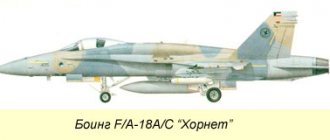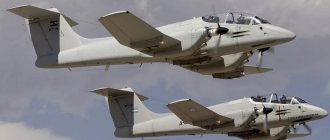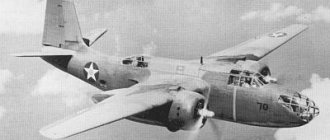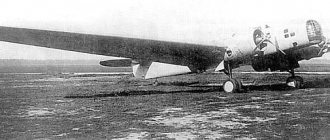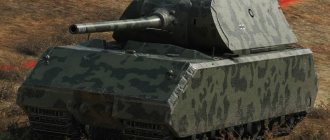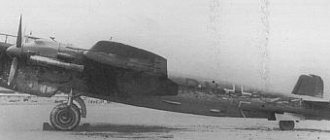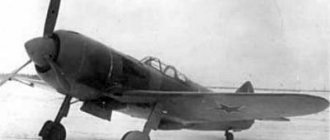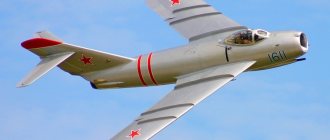F/A-18 Hornet Dimensions. Engine. Weight. Story. Range of flight. Service ceiling
McDonnell Douglas F/A-18 (eng. McDonnel Douglas F/A-18 Hornet (Russian hornet, pronounced "Hornet") is an American carrier-based fighter-bomber and attack aircraft, developed in the 1970s. Today it is the main combat aircraft by US Navy aircraft. It is in service with a number of countries in Europe and Asia, and was used in military operations in Libya, Iraq, and Yugoslavia.
F/A-18 Hornet - video
In a number of sources, the aircraft is referred to as the F-18, which is incorrect, since this designation was abolished in 1982. The correct designation for the aircraft in the US Armed Forces, according to the official list of aircraft designations of the US Department of Defense, (DoD 4120.15-L, May 12, 2004) is FA-18, but the spelling without the slash is not common and is not usually found even in aviation reference books. The F-18 designation is currently officially used by the Finnish Air Force.
History of creation
The F/A-18's roots go back to an early Northrop design, designated the P.530 Cobra, designed in the mid-1960s. Subsequently, this project was redesigned (P.600) and, under the designation YF-17, took part in the US Air Force competition to create a light fighter LWF (Lightweight Fighter). Its competitor was the YF-16 aircraft from General Dynamics. In January 1975, the competition ended with the victory of the YF-16, the future F-16 Fighting Falcon. The story of the Northrop aircraft could have ended there, but around the same time the Navy Air Combat Fighter (NACF) program was launched. Due to a decrease in military spending during this period, the program did not provide for the development of a new aircraft from scratch, but the adaptation of existing projects. The US Navy was skeptical of the single-engine YF-16 and chose to go with the twin-engine YF-17, which, however, required significant modifications for naval service. Northrop had not previously been involved in the creation of carrier-based aircraft, so it was decided that work on the redesign of the YF-17 would be carried out jointly with McDonnell Douglas, which has extensive experience in cooperation with the Navy.
On March 1, 1977, it was announced that the new aircraft would be called Hornet.
The initial plan was for McDonnell-Douglas to handle the carrier-based variant for the US Navy, and Northrop to handle the land-based F-18L variant intended for export. However, in 1979, Northrop filed a lawsuit, accusing its partner of using its technology developed for the ground version, in violation of a bilateral agreement, and demanding a ban on the export of the deck modification. The legal battle ended in 1985 when McDonnell-Douglas agreed to pay $50 million for the technical information obtained; that's how it all ended. The F-18L variant never went into production, and the Hornet completely became a McDonnell-Douglas project.
The aircraft was to be produced in three modifications: the F-18A fighter, the A-18A attack aircraft, and the TF-18A combat trainer. The McDonnell-Douglas company managed to combine the fighter and attack modifications into one aircraft, which since 1980 has been referred to as the F/A-18A, although this designation was officially approved only in December 1982. The two-seat TF-18A was redesignated F/A-18B.
9 single-seat and 2 double-seat prototypes were built. The Hornet made its first flight on November 18, 1978. The first production aircraft took off on April 12, 1980, and in May new aircraft began to arrive in the Navy.
In 1996, the aircraft were modernized: the airframe was strengthened, new internal fuel tanks made of polyurethane were installed (which increased the fuel supply by 160 kg and the tactical range by 5%).
In 1979 prices, the purchase cost of one aircraft, excluding the cost of R&D, was $10.8 million.
The cost of the F/A-18C and F/A-18D is about $29 million (2009 data) The cost of the F/A-18E/F Super Hornet is about $57 million (2009 data)
Design
At the request of the US Navy command, when designing the F/A-18, much attention was paid to survivability and reliability. The small dimensions of this aircraft, non-smoking engines, small effective dispersion area (ESR), weak infrared radiation, and the presence of on-board electronic warfare equipment - all this makes it difficult to detect and track the aircraft. Normal operating overloads are 7.5 g.
The aircraft is designed according to a normal aerodynamic design with a mid-mounted trapezoidal wing. The airframe is designed for a service life of 6 thousand hours with 2 thousand take-offs using a catapult and 2 thousand landings using a delay hook. The design of the aircraft airframe provides for duplication of paths for transmitting power loads.
The fuselage is semi-monocoque. The cockpit compartment is made in the form of a safely damaged structure. The tail is swept. The differential all-moving stabilizer has a reverse lateral V angle of 2 degrees. The vertical tail with two fins deflected outward by 20 degrees is shifted forward relative to the stabilizer to move it out of the aerodynamic shadow of the wing and stabilizer at high angles of attack.
The wing is multi-spar, folds along lines passing through the inner chords of the ailerons with the consoles rotated 90 degrees. The wing is equipped with deflectable leading edges along the entire span, single-slot flaps and hovering ailerons. The tips and flaps are automatically deflected depending on the angle of attack and Mach number to improve maneuverability in combat and aerodynamic quality in cruising flight. One of the distinctive features of the aircraft is the presence of complex-shaped swells in the plan in front of the root parts of the wing. The swells create a vortex lift force and ensure aircraft flight at high angles of attack. There is a gap between the bulges and the fuselage to divert the fuselage boundary layer from the air intakes.
Australian Air Force F/A-18 exhaust nozzles, March 2009.
The aircraft's power plant consists of two F404 engines of a modular design, developed by General Electric specifically for the F/A-18. The engines are separated by a titanium firewall. The thrust of one engine is enough to return the aircraft to its base. All engine components are located in the lower part, under the compressor. The power plant compartment has fire detection and extinguishing systems. The side air intakes are semicircular, non-adjustable, located under the wing root flaps.
The F/A-18 fuel system consists of six fuselage protected tanks and wing soft caisson tanks. All fuel tanks are filled with foam plastic to prevent explosions in the event of combat damage. Both fuselage fuel tanks, containing the fuel needed to return to base, are looped. Both engines can be powered from any supply tank. The fuel system is equipped with shut-off valves, and the fuel tanks are located outside the engine area. There is a system for monitoring damage to the walls of the air path channels adjacent to the fuel tanks. The internal free compartments adjacent to the fuel tanks are filled with rigid foam to prevent fire in the event of joint combat damage. Fuel supply lines are also covered with protector.
The aircraft is made mainly of aluminum alloys (mass fraction 49.6%), high-strength steels (16.7%), titanium alloys (12.9%), composite materials (9.9%) and other materials (10) are used. ,9 %). All control surfaces, tail and flaps are of laminated construction with aluminum honeycomb core and epoxy carbon fiber skin. Part of the wing skin and the fuselage inspection hatch covers are also made of carbon fiber. The stabilizer and fin toes are made of titanium alloys. The design of the aircraft landing gear (cylinders of the main struts) uses high-strength steel AerMet 100 from Carpenter Technolodgy with a tensile strength of 200 kgf/mm2.
F/A-18B Hornet landing on the aircraft carrier Ronald Reagan
On-board equipment
The F/A-18 is equipped with a digital fly-by-wire control system with quadruple redundancy.
The aircraft's powerful computing complex includes over 20 computers with a total memory capacity of 741,000 16-bit words. The main ones are two AN/AYK-14 computers (from Control Data) with a memory capacity of 64,000 16-bit words. In the flight control system, four onboard computers provide control of the F/A-18 aircraft in roll, pitch and yaw. Each computer operates autonomously and is located in a separate compartment, which ensures increased survivability of the aircraft fly-by-wire control system. control commands are generated using averaged signals from all onboard computers. If one, two or three computers fail, control is carried out by the remaining computers. If all computers fail, the pilot switches to a mechanical control system. Some F/A-18Ds were equipped with an ATARS reconnaissance system equipped with IR sensors. All Hornets are equipped with radar and on-board protection systems - warning systems for enemy radiation, as well as a kit for discharging heat traps and dipole reflectors.
F/A-18 from the 212th Fighter Bomber Squadron of the US Marine Corps
Modifications
F/A-18A - the first production version. 371 vehicles were built.
F/A-18B is a two-seat combat trainer version of the F/A-18A.
F/A-18C - variant with improved avionics and weapons (can carry AIM-120, AGM-65 missile launchers).
F/A-18D is a two-seat combat trainer version of the F/A-18C.
F/A-18E Super Hornet is a further development of the F/A-18C variant.
F/A-18F Super Hornet is a further development of the F/A-18D variant.
EA-18 Growler - two-seat electronic warfare aircraft developed on the basis of the F/A-18F
In service
Australia - 55 F/A-18A, 16 F/A-18B and 24 F/A-18F, as of 2016
Spain - 20 F/A-18A (EF-18A) and 54 EF-18A, as of 2016. Some components were produced by the Spanish company CASA. In addition, another 24 all-American vehicles were received from the US Navy.
Canada - 59 F/A-18A (CF-18AM) and 18 F/A-18B (CF-18BM), as of 2016
Kuwait - 31 F/A-18C and 8 F/A-18D, as of 2016
Malaysia - 8 F/A-18D, as of 2016
USA - 272 F/A-18F, 288 F/A-18E, 375 F/A-18C, 56 F/A-18A++, 30 F/A-18A/A+, 16 F/A-18B and 133 F/A -18D, as of 2016
Finland - 55 F/A-18C and 7 F/A-18D, as of 2016
Switzerland - 25 F/A-18C and 6 F/A-18D, as of 2016
At various times, the possibility of acquiring the F/A-18 was considered by Austria, Hungary, Poland, Singapore, the Philippines, the Czech Republic, and Chile. Several aircraft were ordered by Thailand, but the order was canceled after the 1997 Asian financial crisis.
Exploitation
The first F/A-18 squadron became combat-ready on January 7, 1983, the United States Marine Corps Fighter Bomber Squadron 314, Black Knights (VMFA-314 Black Knights). In squadrons of the Navy and Marine Corps, the Hornet gradually replaced F-4 fighters and A-4 and A-7 attack aircraft. After the retirement of the A-6 attack aircraft in the 1990s, the Hornet remained the Navy's only dedicated strike aircraft, and since the retirement of the F-14 fighter in 2006, it remains the only combat aircraft based on American aircraft carriers. This situation will continue until the F-35 Lightning II fighters enter service.
Since 1986, F/A-18 aircraft have been used by the US Navy's Blue Angels aerobatics team.
By the end of the 1990s, Hornets were in service with 26 combat squadrons of the US Navy, 4 squadrons of the US Navy Reserve, and 16 combat squadrons of the US Marine Corps.
Some F/A-18As have already flown 8,500 hours
The cost of one hour of flight is $18,700
Combat use
- Operation Eldorado Canyon - Libya, April 1986
- Gulf War - Liberation of Kuwait, 1991. The F/A-18 was widely used for bombing and air cover during Operation Desert Storm. They accounted for 2 downed Iraqi MiG-21s, and both MiG-21s were shot down during a bombing mission; The Hornets carried bombs, and after destroying Iraqi fighters with air-to-air missiles, they continued to carry out the combat mission, thus confirming their versatility - this was the first time in history that aircraft with a heavy bomb load won a victory over light fighters in air combat. The F/A-18 also destroyed a MiG-23 taking off at the airfield, while one Hornet was shot down by an S-75 air defense missile. On the first day of the war, a group of 10 Hornets is intercepted by a single MiG-25 interceptor, one of the F/A-18s is hit by a missile and falls to the ground, the pilot is killed, becoming the first casualty in Operation Desert Storm. Iraqi MiG returns to the airfield. Losses amounted to 7 Hornets destroyed and more than 10 damaged.
- Operation Deliberate Force - bombing of Bosnian Serb positions, 1995
- Operation Desert Fox - bombing of Iraqi military targets, 1998
— Military operation in Afghanistan — since 2001.
— Iraqi war — the operation to overthrow the regime of Saddam Hussein, 2003–2010. By 2008, at least 5 F/A-18s had been lost.
— Operation Odyssey Dawn — bombing of military facilities of the Gaddafi regime, Libya, 2011
— On July 4, 2003, an American F/A-18 was intercepted by an Indonesian Air Force F-16A fighter. The planes separated and things did not come to the point of opening fire.
The result of a Strela-2 MANPADS missile hitting the nozzle of the left engine of an F/A-18 during the Gulf War (1991). The aircraft, serial number 164051, returned to base and was repaired
F/A-18 "uNPMHR", YANGYUMMSHI BN BRNPNI ONKNBKHME 1970-U CC. MU AYUGE SHYAOEPHLEMRYUKEMNTSN HYARPEAHREK MYUGELMNTSN AYUGHPNBYUMH "mNPRPNO" YF-18 (NYAMNBMNTSN YANOEPMKHYU YAYULNKERYU "dFEMEPIUK DYuIMSHHLHYA" YF-16 B YNMYSPYAE, NAZ ЪBKEMMNL bbya yyu MU OPNRNRKHO KETSINTSN KHYARPEAHREK VERBEPRNTSN ONYNKEMKH), I YAYULNTSN MYUVYUKYU OPEDMYUGMYUVYUKYA DK PEEMKH YUY VHYARN "HYARPEAHREKEMSHU", RYU X SDYUPMSHU GYUDYUV. b 1980s CC. NM, BLEYARE I RFEFKSHL KHYARPEAHREKEL-OEPEUBYURVKHYNL F-14 “rNLYSHHR”, OPYURHVEYAYH ONKMNNYARECH GYULEMHK MU OYUKSAYU YULEPHYUMYAYKHU YUBHYUMNYAZHEB LMNTsNZHEKEBSHE YYULNKERSH F-4 “t YMRNL" II. nDMuYN EYAKH B PNKKH OEPEUBYURVKHYNB obn X KHYARPEAHREKEY GYUBNEBYUMKH OPEBNYAUNDYARBU B BNGDSUE "rNLYSHHR" X "UNPMHR" OPYURKHVEYAYKH ONKMNYARECH OEPEYPSHBYUKH "MHHS" "TYUM" RNLYu", NAEYAOEVHBYU DNYARYURNVMN SHTTEYRKHBMSCH OPNRKHBNBNGDSMSCH X OPNRKHBNPYYERMSCH NANPNMS YULEPKHYUMYAYKHU YUBKHYUZHNMMSHU TsPSOO KH YANEDKHMEMKHI, RN SDYUPMSHE BNGLNFMNYARKH F/ A-18 ON ONYUGYUREKCH "ANEBYU MYUTSPSGYU/DUKEMNYARE" MEYAYNKEIN SYARSOYUKH YANNRBERYARBSCHYELS OYUPYULERPS ANKEE RFEFKNTSN F-4. yYUY YAKEDYARBHE, B YUMYUKHRKHVEYAYHU ZHEMRPUU fucking X MU THPLE LYUDNMMEKK-dSTSKYUYA MYVYUKKHYAE HYAYAKEDNBYUMKH BNGLNFMNNYAREI DUKEMEYETSN YANBEPYEMYARBNBYUMHYU "rNLISHCHRYU", YUZHEMRKHPNBUMMSHE, B OEPBSCH NVEPEDE, MU ONBSHYEMXX SDYUPMNTSN ONREMZHHYUKYU YUBHYUZHNMMNTSN YNLOKEYAYU.
15 KhChKЪ 1987 Ts LHMKHYARP NANPNMSH yyu MUOPYUBHK YNLYUMDNBYUMHCH BNEMMN-LNPYaNTsN TKNRYu DHPEYRHBS I RPEANBYUMHEL MYUVYURE PYUANRSH ON TKSANYNI LNDEPMKHGYUZHHH NYAMNBMNTsN OYU KSAMNTSN HYARPEAHREK - F/A-18.
HYAYAKEDNBYUMH OSREEI LNDEPMKHYUZHHH F/A-18 OPNBNDHKHYAE SOPYUBKEMHEL OEPYAOEIRKHMSHU HYAYAKEDNBYUMKHI LHMHYAREPYARBU NANPNMSH DARPA YANBLEYARMN I fucking X THPLNI LUYDNMMECK-dSC KYUYA (SCHRYU OPNTsPYULLYU ONKSVKHKYU NANGMYUVEMHE "uNPMHR"2000), YU RUYFE DARPA B PYULYUU OYUPYUKKKEKEMNI OPNTsPYULLSH "yaSOEP uNPMHR". ONYAKEDM OPEDSYALYURPHBYUKYU YUMYUKHG RYUKHU SHYGNRKHVEYAYKHU MNBYUZHHI, YUY YAKHYARELYU SOPYUBKEMKH BEIRNPNL RYTSKH DBKHTSYUREKEY, ZHEKEMNONBNPNRMNE AKHGYNPYUYAONKNFEMNE Y YPSHKS OEPEDMEE TsNPKHGNMRYUKEMNE NOEPEMKHE, DNONKMKHREKEMSHE ZHEKEMNOBNNPNRMSHE SOPYUBKYCHYKHE ONBEPUMNYARKH OND GYUDMEI YPNLINEY YPSHKYU KH "OPSHFINBNE" YUYAYAH (R.E. YUYAYAH, YAN NAYYUYUYUYE YYULNKERS OPH BGKARE DNONKMHREKEMSHI BEPRHYUKEMSHI HLOSKEY) .
b 1991 Ts. y ShchRNLS BPELEMH fucking yayu SFE NRYUGYUKKHYAE NR OPNDNKFEMHJ PYUANR MYUD LYUKNGYULERMSHL OYUKSAMSHL RSPLNBKHYNL-ANLAYUPDHPNBYKHYNL “LYUDNMMEKKdSTSKYUYA/ANHMC” yu-12 “yuBEMDFE P", Y OEPYAOEIRKHBSH YANGDYUMKH OYUKSAMNTSN BYUPKHYUMRY KHYARPEAHREK NATF (NLNPVEMMSHI F-22) YARYUMNBKHKHYAE BYAE ANKEE SHTELEPMSHLH. b YNMZHE 1991 Ts .
, BYAINPE ONKSVKHBIETSN KHL "SSOEP uNPMHR". MNBSHI YAYULNKER DNAFEM ASHK NRKHVYUREYA NR YABNETSN OPEDEYARBEMMKHYU - F/A-18C/D YPSHKNL I SBEKKHVEMMNI MU 25% OKNYYUDECH MU 25 LL ANKEYEI YARPNHREKEMNI BSHYANRNNI B YNPMEB NOR VYYARH. yPNLE RNCN, BMNYAHKHYAE KHGLEMEMKH B YNMYARPSYZHCH BNGDSUNGYUANPMKHYU, B YANYARYUB apschn X BNNPSFEMKHE. dKYYULNKERYU OPEDONKYUTSYUKNYAE YANGDURE MNBSC LNDKHTHYUZHCH DBKHTSYUREK I RTsNI, SBEKHVEMMNI DN 10000 YTSYA.
OPEDONKYUTSYUKNYAE SBEKHVKHRE LYUYAYAS ANEBNI MYUTSPSGYKH, PYUYAHPHRE ITS MNLEMYKYURSPS, MU 38% SBEKKHVKHRE PYUDKHSYA DEIYARBKH YYULNKERYU ON MYUGELMSHL ZHEKL, YADEKURE KHYARPEAHREKE OPH BGKERE H ONYYUDYE LEMEE GYUBHYAHLSHL NR YAYNPNYARKH YSPYU YNPYUAK, YU RUYFE YAHKSH BERPYU.
gyu YAVER OPKHMIRKH LEP ON YAMHFEMKHCH PUDHNKNYUZHNMMNI GYULERMNNYARKH LHMKHLYUKEMSCH shp YYULNKERYU B YSPYANBNI OKNYAYNYARKH MYULEVYUKNYAE SLEMEHRE DN 1.19 L2 (R.E. B MEYAINKEY N PYUG LEMAYE OH YAPYUBMEMHCH I HYARPEAHREKEL F/A-18C). b RN FE BPEL LYUMEBPEMMNYARE “SSOEP uNPMHRYU” ONKSVYUKYUYAE ME KSVIEI, VELS WITH KHYARPEAHREK F/A-18C/D; LYUYAKHLYUKEMN DNOSYARKHLSHI SCSC YURYUYKH, YUY X MU YAYULNKERE F/A-18C, NTsPYUMHVKHBUKYA BEKHVKHMNI 30-35 CPYUD.
7 DAYUAP 1992 Ts. ASHK ONDOKHYYUM YNMRPUYR YARNHLNYARECH 3715 LKM.DNKK. MU ONKMNLYuYaRYuAMSCH PYUGPYUANRYS X ONYARPNIIS YYULNKERYU F/A-18E/F, OPEDSYALYURPHBYUCHIKHI OPNBEDEMKHE mkhnip B REVEMHE 7.5 KER, YU RUYFE KhGTSNRNBKEMKHE ORKH NOSHRMSHU ND MNLEYARMSHU HYARPEAHREKEY F/A-18E X DBSU DBSULEYARMSHU SVEAMN-ANEBSHU F/A-18E. b RNL FE TsNDS I THPLNI dFEMEPYUK schKEIRPHY ln GYUYKCHVHKN YNMRPYYR YARNHLNYARECH 757 LKM.DNKK. MU ONKMNLYUYUAMSCH PYUGPYUANRYS rpddt F414 DKЪ MNBNTsN YAYULNKERYU.
rNPFEYARBEMMYU BSHYURYU NOSHRMNTSN HYARPEAHREK YANYARNKYUYAE 18 YAEMRAP 1995 C. MU GYUBNDE B Ts.SEMR-kSKHYA, Y OEPBSHI ONKER "SSOEP uNPMHRYU" YANYARNKYA 29 MN JAP 1995 Ts.
SEPKHIMSHI BSHOSYAY F/A-18E/F MYUVYUKYAJ MU YUBKHYUGYUBNDE B SEMR-KSKHYAE. b 1997-L THMYUMYANBNL TsNDS ASHKN GYUYUGYUMN 12 YAYULNKERNB (BNYAELE F-18E X VERSHPE F-18F), B 1998 T.Ts. - BNYAELE F-18E X 12 F-18E, B 1999 T.Ts - 14 F-18E X 16 F-18F. b 2000-2004 CC. OPEDONKYUTSUERYA GUYSOKHRE 284 YAYULNKERYU, YU NAYKHI NAZEL GUYSONY "SSOEP uNPMHRNB" DK blS Sue H ynPOSYAYU LNPYAYNI OUNRSH DNAFEM YANYARYUBKHRE NR 548 DN 785 LYUHM. SRNHLNYARE NDMNTsN YEPKHIMNTSN KHYARPEAHREK, OPEDMYUGMYUVEMMNTSN DK YULEPKHYUMYAYNTSN TKNRYU, YANYARYUBKYER 42 LKM. DNAK., Yu OPH ONYARYUBYUU MU SHYYAONPR - 51.2 LKM.DNKK.
oEPBSHI YAEPHIMSHI YYULNKER F/A-18E/F ASHK ONYARYUBKEM YARPNEBNI SCHAYYUDPHKEE blS Sue B MNYAPE 1999 Ts b YANNRBERYARBHKH I YASYEYARBSCHYHLH OKYUMYULH, LMNTsNZHEKEBNI KHYARPEAHRE KE F/A-18E/F BLEYARE JAN JABNHL OPEDEYARBEMMKHYNL F/A-18C/D I MYUVYUKY DEYARHKERKH DN 2010 C ASDSR ЪБКЪРЭЯЪ TYURHVEYAYH EDHMYARBEMMSHHLH ANEBSHHLH YAYULNKERYULH MU OYUKSAYU YULEPHYUMYAYHU YUBHYUMNYAZHEB. dBSULEYARMSHI KHYARPEAHREKE F/A-18F YAN BRNPNI ONKNBKHMSH REISYETSN DEYARKHKERKH OPHDER MU YALEMS KHYARPEAHREKCH-OEPEUBYURVHYS F-14 “rnLYSCHR”, BSHONKMCHYELS GYUDYUVH obn YUBKHYU MNYAMNTSN YANEDKHMEMKH, OYUKSAMNLS YAYULNKERS pshcha eyey-6b, YU RUYFE ASDER BSHONKMRE PNKE YAYULNKERYU SOPYUBKEMKH KH MYUBEDEMKH. nDMNLEYARMSHI F/A-18E ASDER PEYURE GYUDYUVKH HYARPEAHREK GYUBNEBYUMKH TSNYAONDYARBU B BNGDSUE KH OYUKSAMNTSN LRSPLNBKHYU (PYUMEE BNGKYUTSYUBKHEYA MU yu-6e). yPNLE RNTsN, PYYAYALYURPHBUERYA BNGLNFMNYARE HYAONKEGNBYUMH LMNTsNZHEKEBNTSN KHYARPEAHREK "SSOEP UNPMHR" B YUVEYARBE YYULNKERYU DK MUMEYEMH BSHYANINRNVMSHU SD YUPNB X YAYULNKERYU-GYUOPYUBYHYU.
oEPBSHL XG SHYYAONPREPNB F/A-18F LNFER YARYURE LYUKUIGH: B 2005 Ts. ShchRYU YARPIUMYU MYULEPEMYU OPHNAPEYARH 16 LMNTSNTSMYZHNMYUKEMSHU HYARPEAHREKEY I SBEKHVEMMNI DUKEMNYA RECH (MU LYUKUIGHIYAYNL PSHMYE YNMYSPEMRYULH "SSOEP uNPMHRS" BSHYARSOYUCHR PNYAYAHYAYKHE LYUHMSH YAS-30ly X lHts-29l2). eYE NDMHL ONREMZHYUKEMSHL ONYSOYUREKEL YAYULNKERYU ЪБКЪерЯ юБИАРПУКХЪ, YNRNPYUKH B PYULYUU OPNTsPYULLSH Project Air 6000 PYYYYALYURPHBYUER BYUPHYUMRSH GULEMSH ANLAYUPDHPNBYKHY NB F-111ya X F-111G, Yu RUYFE HYARPEAHREKEY F/yu-18A/b.
SKEDSER OPHGMURE, VRN KHYARPEAHREKE F/A-18E/F NAKUDUER DNYARYURNVMN BSHYANYHL SHYYAONPRMSHL ONREMZHHYUKNL. nM YAONYANAYE YANYARYUBHRE YNMYSPEMZHCH RUYHL LYUHMYUL, YUY YAS-30ly, YAS-35, LHts-29L(l2), LHts-29y, F-16C/D Block 60, YU RUYFE EF2000 X "pYUTYUKE". ETSN AKKHFUYYKHI PNYAYAKHIYAYKHI YUMYUKNTs - lHts-29y - KHLEER YANKHGLEPHLSHE BNGLNFMNYARKH YAHYARELSH SOPYUBKEMKH BNNPSFEMKHEL (Ssb), KSVIE YAYNPNYARMSHE, BSHYANRMSHE X LUMEBPEMMSHE YUYUPYUREPHYARKHYH, NDMUYN MEYAYNKEIN SYARSOYUER YLEPHYUMYAINLS YANOEPMHYS ON OYUPYULERPS "ANEBYU MUTSPSGYU/DUKEMNYARE". b RN FE BPEL PNYAYAHYAYYU LYUHMYU ANKEE YNLOYUYRMYU (VRN NYNAEMMN BYUFMN OPH PYUGLEYEMKH HYARPEAHREKEY MU YUBHYUMNYAZHYUU MEANKENTSN RNMMYUFYU).
b MUYARNYEE BPEL BLS Sue HGSVYUERYA YNLOKEYA LEP ON DUKEMEYELS YANBEPEMYARBNBUMHCH KHYARPEAHREK F/A-18E/F, MUOPYUBKEMMSHI MU ONBSHYEMHE ETSN YNMYSPEMRNYAONYANAM NYARH MY BMEMEL PSHMYE. b VYUYARMNYARKH, OPEDONKYUTSUERYA SLEMEEMHE YAHTSMYURSPSH apkya, SBEKKHVEMHE BNGLNFMNYAREI ON MYUMEYEMHCH BSHYANINRNRNVMSHU SDYUPNB ON MUGELMSHL ZHEKL, BMEDPEMKHE YNMTNPLMSHU RNOC KHBMSHU AYUNB, YU RUYFE PEYUKHGYUZHKH LEPNOPHYRKHI ON SLEMEEMKHCH YARNHLNYARKH YAEPKHIMNTSN YAYULNKERYU.
SRNHLNYARE NDMNTsN KHYARPEAHREK F/A-18E B SCHIYAONPRMNI YNMTHTSSPYUZHKH DNAFMYU ASHRE SLEMEYEMYU I 57-59 DN 42 LKM.DNAK. PYYAYALYURPHBYUCHRYA OSRKH DUKEMEETSN YAMKHFEMKH YARNHLNYARKH YEPKHIMSHU LYUHM EYY MU 7-10 LMB. DNAK. OPH SCHRNL YASLLYUPMSHI ANEBNI ONREMZHHYUK LNDEPMKHGKHPNBUMMNTSN KHYARPEAHREK DNAFEM ASHRE ME LEMEYE ONREMZHYUKYU RYUKHU YYULNKERNB, YUY "eBPNTYUIREP" EF2000 "rYuITSM", JAS 39 “tsPHOEM” KH “DUYAYAN” “pYUTYUKE”, YU RUYFE PNYYAHYAYKHU HYARPEAHREKEY lHts-29Slr KH YAS-27YAL, ONEBKEMKHE YNRNPSHU MU LEFDSMYUPNDMNL YUBKHYUZHNMMNL PSHMYE NFKHDUERYAJ YAEPEDKHME REISYETSN DEYARHKERKH.
TKhPLNI PEIRENM DK KHYARPEAHREK "SSOEP UNPMHR" YANGDUERYA MNBU apkya AN/APG-79 I YUYRKHBMNI YUMREMMNI TYUGHPNBUMMNI PEERINI (youtube). SRYUMZHKH DNAFMYU NAKYUDURE YAONYANAMNYARECH NAMYUPSPHBYURE ZHEKH YKYUYAYU "HYARPEAHREKE" MU DUKEMNYARH DN 150-165 YL (VRN ONVRH BDBNE OPEBSHUER DUKEMNYARE DEYARBKH apkC AN/APG-73). OPEDONKYUTSUERYAJ, VRN MNBSHI PYUDYUP ASDER TSNRNB Y OPEDYUVE B YAEPKHIMNE OPNKHGBNDYARBN B 2006 Ts. YUMHPSERYA GYUYUGYURE I 2006 T.Ts.). dK YAMKHFEMKH PUDHNKNYUZHNMMNI GULERMNYARKH YUMREMMYU apkS ASDER SYARYUMNBKEMYU OND STSKNL Y BEPRKHYUKEMNI OKNYAYNYARKH (YA OKNYAYNI YUMREMMNI PEERYNI, NPHEMRKHPNBUMMNI BBEPU ).
lnyyu apkC I YouTube NAEYAOEVKHBUER BNGLNFMNYARE OPHLEMEMKH B YANYARYUBE BNNPSFEMKH YAYULNKERYU F/A-18E/F OEPYAOEIRKHBMSHU PUYER "BNGDSU-BNGDSU" SBEKHVEMMNI H ANKENNY DUKEMN YARH, NAEEAOEVHBUCHYHU NOEPEFYUCHYE ONPUFEMHE HYARPEAHREKEY OPNRRHBMKHYU.
b YUBTSSYARE 1995 C. THPLYU LYuDNMMEKK-DSTSKYUYA OPEDKNFHKYU B KHMKHZHYURKHBMNL ONP'DYE YANGDURE MU AYUGE KHYARPEAHREK "SSOEP uNPMHR" YAYULNKER pscha F/A-18C2W, OPEDMYUGMY VEMMSHI DK GULEMSH ONYAKE 2008 C YAYULNKERYU EA-6B "oPUSKEP", YU RUYFE BSHONKMEMHYUDYUV YABNENAPUGMNTSN KERYUCHYETSN yo , NYASYYYARBKYETSN SOYUBKEMKHE DEYARBKHLH DPSTSKHU YAYULNKERNB. OPH ShchRNL HGLEMEMKH YNMYARPSYZHKH HYAUNDMNTSN KHYARPEAHREK OPEDONKYUTSYUKNYAE YABEYARKH Y LHMHLLSLS: MU YNMZHYUU YPSHKYU BLEYARN sp "yaYUIDSKHMDEP" MYULEVYUKNYAE PUGLEYARHR E
YNMREIMEPSH I YOOOOYUPYURSPNI PUDHNSCHKEIRPNMMNI PUGBEDYKH, DPSTSNE NANPSDNBYUMKHE pshcha OKYUMKHPNBYUKNYAE PUYAONKNFHRE B YNMREIMEPYU MU ONDIPSHKEEBSHU SGKYUU ONDBEYAYKH. gyu YYUAKHMNI SHYKHOYUFYU OPEDONKYUTSYUKNYAE SYARYUMNBHRE OPHELMKHY YAOSRMKHYNBNI MYUBKHTSYUZHNMMNI YAHYARELSH. naYYU ONRPEAMNYARE blS X bbS Sue B YAYULNKERYU DUMMNTSN RHOYU NZHEMHBUKYUYAE B 150 EDHMKHZH.
F/A-18C2W KETS B NYAMNBS OPNEYRYU EA-18G “tsPNSKEP”, OPEDTKNFEMNTSN THPLNI ANKHMTs (YNRNPYU YARYUKYU “BKYUDEKEZHEL” OPNTsPYULLSH F/A-18 ONYAKE ONTSKNYEMKH ONYAKEDMEI THPLSH LUYDNMMEKK-DSTSKYUYA) B 2001 Ts.H OPEDMYUGMYUVEMMNTSN DK BEDEMH PSHCHA, SOPYUBKEMKH DEYARBKHLH ANEBSHU aokyu (RHOYU UCAW X UCAV-N), BEDEMH PUGBEDYKH, YU RUYFE PEYEMKH DPSTSKHU "BSHYANYNHMREKKEYRSYUKEMSHU" GYUDYUV.
b PYULYUU OPNTsPYULLSH AMLCD I 1998 C BEDSRYA PUANRSH ON YANGDYUMHCH DK OEPYAOEYRKHBMSHU LNDKHTHYUZHHI DBSULEYARMNTSN YYULNKERYU F/A-18F MNBNTSN KHMTNPLYUZHNMMN-SOPIUBKYETS N ONK GYUDMEI YUAHMSH, YNRNPNE ASDER BYKCHVYURE DBU ZHBERMSHU DHYAOKE TNPLURNL 10U8 DCHILNB (250U200 LL). lNDEPMKHGKHPNBUMMNE OPHANPMNE NANPSDNBYUMKHE B GYUDMEI YYUAHME YAYULNKERYU "tsPNSKEP" ONGBNKHR SHCHYHOYUFS KH DBSU VEKNBEYRE GYUDYUVH, YUMYUKNTSKHVMSHE GYUDYUVYUL VERSHPEULEYARMN TsN YAYULNKERYU-6b.
YANGDYUMKHE YYULNKERYU-GYUOPYUBYHYU MU AYUGE KHYARPEAHREK F/A-18E/F OPH OPEDYUVE MU SDYUKEMHH 610 YL 2900 YTS RNOXBYU NAEYAOEVHR SBEKHVEMKHE ANEBNTSN PYUDKHSYU DEIYARBKH "SSOEP-uNPMHRYU" DN 1600 YL, Y DUKEMNYARKH ONPUFEMHJEKEY ONYAPEDYARBNL NOEPYURKHBMN-RUYRHVEYAYNI ip SLAM-ER — DN 1850 YL. ONYAKE PEYEMKH GYUDYUVKH ON DNGYUOPYUBYE B BNGDSUE YAYULNKER-GYUOPYUBYKHY LNFER ASHR ASHRE OPHBKEVEM Y BNGDSMNLS OYURPSKHPNBYUMKHCH B ZHEKYU NAEYAOEVEMKH obn YUBKHYUMNYAZHYU.
b ZHEKYU ONBSHYEMKH KERMSHU UYUPYUREPKHYARKHY "CSOEP UNPMKHRYU" fucking yayu ONNYPCHR SYAKHKH DBKHTSYUREKYARPNHREKEMSHU THPL Sue ON HYAYAKEDNBYUMKHCH YUKEREPMYURKHBMSHU BYUPKHYUMRNB DBHTSUREK F414-400, SYARYUMNBKEMMNTSN MU SCHRNL YAYULNKERE. OPH SCHRNL PYYAYALYURPHBYUCHRYA YUY ONKMNYARECH MNBSHE RHOSH YAHKNBSHU SYARYUMNBNY, RYU H LNDEPMHGKHPNBUMMSHE BYUPKHYUMRSH rpddt F414 I SBEKKHVEMMNI RCNI. b RN FE BPEL NTHZHHYUKEMN TKNR ME THMYUMYAHPSER SHHRH PYUANRSH. ndMUYN B YAKSVYUE, EYAKH OPYUBHREKEYARBN Sue PE'HR OPEYPYURHRE HKH GYULEDKHRE PEYUKHGYUZHCH OPNTsPYULLSH LMNTsNTSMYZHNMYUKEMNTSN KHYARPEAHREK "kNYUKhD lyuprkhm" F-35C, ONRPEACHRYA GYYSOYH DNONKMHREKEMSHU OYUPRKHI YYULNKERNB F/A-18E/F (ONLHLN 548 LYUHM, GYYSOYU YNRNPSHU OPEDSYALNRPEMYU MSHME YASEYYARBSCHYHLH OKYUMYULH), YU RUYFE BSHDEKEMHE YAPEDYARB MU DUKEMEEEE YANBEPEMYARBNBYUMHE SHRNTSN YYULNKERYU.
ТХПЛУ "оПУРР сХРМХ" ПУЯЯЛУРПХБУер BНГЛНФМНЯРЭ ОПЭНИМУЯИМХ КХЯРПЭАХРИКЪ "ССОП УНПМХР" DBHTSYUREKEL PW7000. oEPBNMYUVYUKEMN SHRNR rpdd PYUGPYUAYURSHBUKYA B PYULYUU OPEYPYUYUMNI B MUVYUKE 1990-U CC. OPNTsPYULLSH LYUKNGYULERMNTSN OYUKSAMNTSN URSPPLNBKHYU ORNTSN ONYNKEMKHYU (yu-12). b DUKEMEIEL DBKHTSYUREKE AEGSYAOEMN OPEDKYUTSYUKYA (B YUVEYARBE YUKEREPMYURKHBMNTSN BYUPKHYUMRYU) DK NYAMYUYEMKH YYULNKERNB “DYUYAYAN” “lHPYUF”2000 (tPYUMZHKH), “jNPEYUM shPYAOEIYA/kNYUKhD LYUPRHM" r/yu-50 (chFMYUJNPEЪ) X "YYYUA/byue YAKHYARELYA" JAS 39 “tsPHOEM” (bBEZHKH/yuMTSKKH).
PW7000 YANGDYUM MU AYUGE "YNLLEPVEYAYNTSN" DBHTSUREK PW6000. b ETSN YNMYARPSYZHKH OPEDONKYUTSUERYA KHYAONKEGNBYURE KH PJD SHKELEMRNB (B VYUYARMNYARKH, BEMRKHKIRNP, RSPAKHMS MHGYNTSN DYUBKEMKHЪ) rpddt F135, OPEDMYUGMYUVEMMNTSN DKЪ NYA MUYYEMH KHYARPEAHREK F-35.
rpddt PW7000 HLEER TSYUAYUPHRSH, OPYUYURKHVEYAYH YUMYUKNTSKHVMSHE TSYUAYUPHRYUL DBKHTSUREK F414-GE-400, NDMYYN NAKYUDYUER MU 25% ANKEYEI RTsNI (R.E. BEKKHVKHMYU LYYYAHLYUKEM NI AEYATNPYUFMNI RTsKH DNAFMYU DNARKHTSYURE 12500 YTSYA). ON SRBEPFDEEMKHCH OPEDYARYUBHREKEY THPLSH oPUURR sHRMH, YAYULNKER F/A-18E/F I MNBSHHLH DBHTSUREKLH DNAFEM NAKYUDURE MU 31% ANKEYEI DUKEMNYARECH ONKERYU X MU 27% KSVIHLH PU GTSNMMSHLH UYUPYUREPHYARKHYULH.
THPLYu dFEMEPIUK schKEIRPHY RUYFE HYAYAKEDSER BNGLNFMNYARH TKSANYNI LNDEPMHGYUZHHH rpddt F414. PYUMEE YPHRKHYKH OPNTSPYULLSH F/A-18E/F SRBEPFDUKH, VRN YAYULNKER SCHRNTSN RHOYU SYARSOYUER ON YAYNPNYARMSHL UYUPYUREPHYARKHYUL ANKEE KETSYNLS HYARPEAHREKCH F/A-18C/D, Yu rp ddt F414-GE-400, YYNASH, ME KHLER OEPYAOEIRKHB ON MYUPYYHBYUMHCH RЪTsKH. nDMuYN THPLYU GYUBKYER, VRN RЪTSYU DBKHTSYUREK B OPNZHEAYAYE LNDEPMHGYUZHHH LNFER SBEKHVKHREYA MU 15-20% (R.E. DNYARKHTSMSRE BEKKHVKHMSH 11500-12000 YTSYA) HKH, OPH YANUPYUMEMHH YASYYYYARBSCHYHU OYUPYULERPNB RTsKH, BNGLNFMN DUKEMEEEE SKSVIEMKHE PEYASPIAMSHU UYUPYUREPHYARKHY rpddt (VRN ONGBNKHR YASYYYARBEMMN YAMKHGHRE SHYAOXYURYUZHN MMSHE PYYAUNDSH ).
pYUANRSH ON LNDEPMHGYUZHKH DBKHTSUREK F414 BEDSRYA THPLNI dFEMEPIUK schKEIRPHY GY YABNI YAVER, YU RUYFE GY YAVER VYUYARKHVMNTSN OPHBKEVEMKH YAPEDYARB fucking, BSHDEKYELSHU MU PUGBHRKHE OEPYAOEIRKHBMSHU REUMNKNTSKHI. OPEDONKYUTSUERYA, VRN OPH BSHDEKEMHH YANNRBERYARBSCHYETSN THMYUMYAHPNBYUMKH HYAOSHRYUMKH SYANBEPEMYARBNBUMMNTSN BYUPKHYUMRY RPDDT SDUYARYA MUVYURE SFE B 2003-200 4 CC.
nyanaemmnyarkh YNMYARPSYZHHH YYULNKERYU "yaSOEP UNPMHR".
ON YAPYUBMEMHCH I YAYULNKERNL F/A-18C/D LMNTsNZHEKEBNI KHYARPEAHREKE F/A-18E/F HLEER SYAHKEMMSHI OKUMEP, SDKHMEMMSHI TCHGEKF, YPSHKN, YPSHKEEBSHE MYOOKSHBSH TsNPKHGNMRYUKE ME NOEPEMKHE SBEKKHVEMMNI OKNYYUDKH, YU RUYFE MNBSHHI BNGDSUNGYUANPMKHY VERSHPEUSTSNKEMNTSN YEVEMKH I SLEMEEMMNNI PUDHNKNYUZHNMMNI GYULERMNYARECH, NAYEOEVKHBUCHYKHI ANKEKHI PYYAUND BNGDSUYU. yYUMYUKSH BNGDSUNGYUANPMKHYU MEYAINKEIN HYAYPHBKEMSH BMHG KH BANY, VRN YAONYANAYARBSER NRPYUFEMKHCH SCHKEIRPNLYUTSMHRMNTSN HGKSVEMKH B YARNPNMS NR NYAH ONKERYU YAYULNKERYU. b BNGDSMNL YUMYUKE, OEPED KNOYURYULH YNLOPEYAYANPU DBKHTSUREK PUGLEYEMSH PYUDHYUKEMSHE OKYUYARKHMSH, RUYFE SLEMEYUCHYKHE PUDHNKNYUZHHNMMNE HGKSVEMKHE, NRPYUFEMMNE NR rp ddt. dPSTSKHE SYANBEPEMYARBNBYUMKH, MUOPYUBKEMMSHE MU SLEMEYEMKHE GYULERMNYARKH, BYKCHVYUCHR OHKNNAPYUGMSHE YPYU YARBNPNY NYAMNBMNTSN YUYAYAH X REUMNKNTSHVEYAYKHU OYUMEKEY DBKHTS YUREKEY, PNLANKHDUKEMSHE LERYUKKKHVEYAYKHE SHYPYUMSH I OPTPNPYUZHHEI, BSHONKMEMMNI LERNDNL KYUGEPMNI NAPUANRYKH, ONYPSHBUCHYKHE MYUPSFMSHE NRBEPYARKH, YU RUYFE YAOJHYUKEMSHE P YUDKHNONTSKNYYUCHYKHE ONYPSHRKH (B VYUYARMNYARKH, GNKNRNE MYOOSHKEMKHE MU TNMYUPE YUAKHMSH) . pBD REUMHVEYAYHU PEYEMKHI ON SLEMEYEMHCH GULERMNYARH PEYUKHGNBYUM B YNMYARPSYZHHH NRYAYU PUDHNKNYUZHNMMNI YARYUMZHHH. MU YAYULNKERE HYAONKEGNBUMSH YAOEZHHYUKEMSHE YNPPNGHNMMN-YARNIYKHE PUDHNONTSKNYYUCHYCHYHE LUREPHYUKSH.
б НРКХВХЕ НР ЯОЕЖХЮКХГХПНБЮММШУ ЯЮЛНКЕРНБ «яРЕКЯ», УЮПЮЙРЕПХЯРХЙХ ЛЮКНИ ГЮЛЕРМНЯРХ ХЯРПЕАХРЕКЪ F/A-18E/F ЦЮПЛНМХВЕЯЙХ ЯНВЕРЮЧРЯЪ Я БШЯНЙХЛХ кру ЯЮЛНКЕРЮ.
b YAKHYARELS ANEBNI FHBSVEYARKH "yaSOEP uNPMKHRYU" BUNDHR MNBSHI TSSAVIURSHI GUONKMHREKE YPSHKEEBSHU RNOKHBMSHU AYUNB, KHLECHYKHI ONMHFEMSCH OKNRMNYARE. b MHFMEI VYUYARKH TCHGEKKFYU PUGLEYEMYU YOOYUPYURSPYU ONFYUPNRSYEMKH I HYAONKEGNBYUMHEL "OYUYAYAHBMNI" OEMSH, OPEDMYUGMYUVEMMYU DK GYUYHRSH TsKHDPUBKHVEYAYKHU YNLLSMKHYUZHHI X OPNBNDYKH YAKHYARELSH SOPIUBKEMKH, OPNUNDYKHU B SCHRNI VYUYARKH OKYUMEPYU. b YANYARYUB OPNRKHBNONFYUPMNI YAKHYARELSH BUNDIR RUYFE YURKHBMSHE DYURVKHYKH, BYKCHVYUCHYKHE YAKHYARELS KHMEPRMNTSN TSYUGYU.
OKNYYUDE MEGYYYHYYEMMNI ONBEPUMNYARH OKYUMEPYU F/A-18E/F SLEMEHKYUYAE DN 13% OH YAPYUBMEMHCH I 25% S F/A-18C/D, UNRЪ MNBSHY YAYULNKER MU 25% YPSOMEE X NAZEL RNOXBY BN B MSRPEMMKHU AYUYUU S METSN MU 33% ANKEYE.
IHKNBUYA SYARYUMNBYU. YaYULNKER NYAMYUYEM DBSL rpddt “dFEMEPIUK schKEIRPHY” F414-GE-400 (2U10000 YTSYA).
bN BMSRPEMMKHU RNKOKHBMSHU AYUYUU PYUGLEYYUERYAJ 8063 TO RNOXBYU. OPH HYAONKEGNBYUMKHH ORRKH ora GYUOYUYA RNOXBYU BNGPUYARYUER DN 17148 K. hLEERYA YAKHYARELYU DNGYUOPYUBYKH B ONKERE (URUMTSYU-RNOKHBNOPHELMKHY B MEPYUANVEL ONKNFEMXX SAKHPUERYA B TCHGEKЪF).
aNPRNBNNE NANPSDNBUMHE. YaYULNKER NYAMYUYEM ONKMNNYARECH ZHTPNBNI YAKHYARELNI DKHYURUMZHNMMNTsN SOPYUBKEMKH, YNMRPNKHPSCHYEI PUANRS SHKEPNMNB, PSKEI MYUOPYUBKEMKH, ZHEKEMNONBNPNRMNTsN TsNPKHGNMRYUKEMNTs N NOEPEMKH, OPEDYPSHKYNB X GUYPSHKYNB.
YANYARYUB apshn MU 90% YUMYUKNTSKHVEM apshn KHYARPEAHREK F/A-18C/D. xMEPZHYUKEMYU MYUBKHTSYUZHNMMMYU YAKHYARELYU I 1999 Ts DNONKMEMYU OPHELMHYNL YAOSRMHYNBNI MYUBKHTSYUZHHH. I 2001 Ts.
pYUDKHNSCHKEYRPNMMSHY YNLOKEYA BYKCHVIUER LMNTsNTSMYZHNMYUKEMSCH KHLOSKEYAMN-DNOKEPNBAYSCH apkya UECHG AN/APG-73 I LYUYAKHLYUKEMNI DUKEMNYARECH NAMYUPSFEMKH BNGDSMSHU ZHEKEY YKYYUYAYU "HYARPEAHREKE" ONP'DYU 80 YL. nMYU YAONYANAMYU YANOPNBNFDURE "MU OPNUNDE" DN 10 JACKEYS X NDMNBPELEMMN MYUBNDHRE MU MKHU VERSHPE sp RHOYU AMRAAM I YURKHBMSHL PYUDHNKNYUZHNMMSHL YAYULNMYUBEDEMHEL. YaRYUMZHKH, YAMYUAFEMMYU YEKEBNI YUMREMMNI PEERINI I LEUUMHVEYAYHL YAYUMKHPNBYUMHEL B TsNPKHGNMRYUKEMNI OKNYAYNYARKH SHCHKEIRPNMMSHL - B BEPRKHYUKEMNI, OBKJERYA DUKEMEY BHL PUGBHRHEL apkya "uECHG" AN/APG-65. sYANBEPEMYARBNBYUMH BYKCHVYUCHR PYYYAHPEMMSHI VYUYARNRMSHY DHYUOYUGNM, SBE-KHVEMMNE ASHYARPNDEYARBHE OPNZHEYANPYU NAPUANRYKH YAHTSMYUKNB X SYARYUMNBYS MNBNNTSN NYAMNBMNTSN OPNZHEYANPYU I SBEKKHVEMMSHL ASHIARPNDEYARBHEL KH PUYAHPEMMNI ELINYARECH OYULRKH.
MU DBSU ONDTCHGEKFMSHU SGKYU BMEMEY ONDBEYAYKH LNTsSR PUGLEYYUREYAJ DBYU YNMREIMEPYU NORKHYN-SHKEYRPNMMNI MYUBKHTSYUZHNMMN-OPKHZHEKEMNI YAKHYARELSH ATFLIR (Advanced Targeting Forvard-Looking Infra Red), B YKCHVYUCHYEI REOKNBKHGKHNMMNE NANPSDNBYUMHE X KYUGEPMSHY DYUKEMNLEP-ZHEKESYUGYUREKE (NAEYAOEVKHBUCHYKHI BNGLNFMNYARE YUBRNMNLMNTSN OPHLEMEMH yua RHOYU "oEIBSCHI").
nANPSDNBYUMKHE YUAHMSH SHCHYHOYUFYU F/A-18E/F OH YAPYUBMEMHCH I F/A-18C/D GMYUVKHREKEMN SYANBEPEMYARBNBUMN. b BEPUMEI VYUYARKH OPHANPMNI DAYYKH PUYAONKNFEM FKhDYNYPHYARYUKKKHVEYAYHI LNMNUPNLMSHHI KHMDHYURNP PUGLEPNL 3U5 DCHILNB (76U127 LL) I RUYRHKEMSHL SOPYUBKEMHEL. OND MHL SYARYUMNBKEM ZBERMNI FHDYNYPHYARYUKKKHVEYAYHI KHMDHYURNP RYURHVEYAYNI NAYARYUMNBYKH (159U159 LL). ON ANYUL OPHANPMNI DAYYH YANUPYUMEMSH DBYU LMNTsNTSMIZHNMYUKEMSHU LNMNUPNLMSHU KHMDHYURNPYU 5U5 LL, OPHLEMYELSHE MU YAYULNKERE F/A-18C/D. hLEERYA LNMNUPNLMSH OPNTsPYULLLHPSELSHI FKhDYNYPHYARYUKKHVEYAYKHI KHMDHYURNP, OPEDMYUGMYUVEMMSHI DK YNMRPNK PYUANRSH DBKHTSUREK H RNOXBMNI YAKHYARELSH.
YNLOKEYA pshcha IDECM BYKCHVUER YARYUMZHCH OPEDSOPEFDEEMKH N PUDHNKNYUZHHNMMNL NAKSVEMHH "UECHG" AN/ALR-67(V)3, ASYYAKHPSELSCH KNFMSCH ZHEKE "PEIRENM" AN/ALE-50, YAKSFYUYSCH DKЪ SB NDYU B YARNPNMS MEOPHЪREKEYAYHU PUYER H B MEPUANVEL ONKNFEMHH PYUGLEYYUELSCH OND TCHGEKFEL, Yu RUYFE VERSHPE AKNYU PYUGAPNYU hy KNBSYEH DHONKEMSHU NRPYUFUREKEY "rPSCHYNP" AN/ALE-47.
bNNPSFEMKHE KHYARPEAHREK F/A-18E/F PYUGLEYYUERYAJ MU 11 SGKYU BMEMEI ONDBEYAYKH. b YANYARYUB sp YKYUYAYU "BNGDSU-BNGDSU" BUNDER PUYERSH LYUKNI DUKEMNYARH AIM-9l "yaYUIDSKHMDEP" (DN 12 EDKHMKHZ), joint venture YAPEDMEI DUKEMNYARKH AIM-7l "yaOSCHPPNS" (DN BNYAELKH EDKHMKHZh) ) ХКХ AIM-120 AMRAAM (DN 12). hLEERYA BURPNEMMYU EYARKHYARBNKEMYU 20-LL AXIS l61yu1.
dKЪ ONPUFEMHYUGELMSHU (MYUDBNDMSHU) JACKEYS LNTsSR HYAONKEGNBUREYA PUYERSH AGM-65 "LEIPBHY" (LEYARE EDKHMKHZH), AGM-88 HARM (LEYARE), AGM-84H SLAM (VERSHPE) ХКХ AGM-84A "tsYuP" OSM" (VERSHPE). YaYULNKER LNFER MEYARKH OKYUMKHPSCHYHE YUBKHYUANLASH AGM-154 JSOW (LEYARE), yua JDAM GBU-32 (YUKHAP 900 YC, VERSHPE EDKHMKHZHSH) XKH GBU-32 (450 YTs, LEYARE EDKHMKhZh), Yu RUYFE yu and I KYUGEPMSHL YAYULNMYUBEDEMHEL RHOYU “OSHIBSHI” II/ III(11 EDHMHJ).
ONYAKE 2002 Ts YAYULNKER DNAFEM ONKSVKhRE MNBSC NOEYURKHBMN-RUYRHVEYAYSCH yp AGM-158 JASSM (DBE yp MU ONDIPSHKEEBSHU SGKYU).
b OEPYAOEIRKHBE MU YALEMS sp AIM-9M DNAFMSH OPHIRKH BSHYANYNLUMEBPEMMSHE PUYERSH AKKHFMETSN AN MNBNTSN ONYNKEMKH AIM-9X (ON YABNHL YUYUPYYREPHYARKHYUL ME SYARSOYUCHYKHE XKH OPENNYA UNDIYKHE PNYYAKHIYAYHE PUYERSH p-73), Y OSYS l61yu1 OKYUMKHPSERYA GYULEMKHRE SYANBEPEMYARBNBUMMSHL, ANKEE KETSIHL NPSDKHEL.
MESOPYUBKELSHE YAPEDYARBU ONPUFEMH BYKCHVYUCHR YABNANDMNOYUDYUCHYHE YUBKHYUANLASH, YUBKHYUZHNMMSHE LHMSH, MUOYUKLNBSHE AYUYKH, ANLANBSHE YUYAYAERSH KH R.O.
NAYEI LYUYAYANI 8050 YC. BYAETSN YAYULNKER LNFER MEYARKH 29 PYUGKHVMSHU YNLAKHMYUZHHI BNNPSFEMKH. cru:
| lNDHTHYUZHH | F/A-18E |
| pYUGLUU YPSHKYU, L | |
| MNPLYUKEMSHI | 11.62 |
| YAN YAKNFEMMSHLH YPSHKELH | 9.32 |
| dKKhMYu, L | 18.31 |
| bSHYANRYU, L | 4.88 |
| OKNYYUDE YPSHKYU, L2 | 46.45 |
| I LOVE YAYULNKERYU, JC | |
| OSYARNCN | 13387 |
| LYUYAHLYUKEMYU BGKERMYU | 29937 |
| rNOKHBN, YC | |
| BN BMSRPEMMKHU AYUYUU | 6531 |
| ora | 4436 (5У1816) |
| RHO DBKHTSUREK | 2 RPDT General Electric F414-GE-400 |
| rЪTSYU, Ym | 2 U 97.90 |
| LYUYAHLYUKEMYYAINPNNYARE MU BSHIANRE YL/V | 1915 (l=1.80) |
| oPUYRHVEYAYU DUKEMNYARE Ya ora, YL | 1280 |
| aNEBNI PYUDKHSYA DEIYARBKH DEYARBKH, YL | 760 |
| oPNDNKFHREKEMNYARE OYURPSKHPNBYUMKH, V | 2.25 |
| oPUYIRKHVEYAYKHI ONRNNKNY, L | 15240 |
| ShYKHOYUF, VEK | 1 |
| bNNPSPHEMHE: | NDMYU 20-LL EYARKHYARBNKEMYU OSYU l61yu1 bSKYUM I 570 OYURPNMYULH. aNEBYU MYUTSPSGYU 8051 YTS. PYUGLEYYUERYA MU 11 SGKYU ONDBEYAYKH: 2 joint venture BNGDSU-BNGDSU AIM-9 Sidewinder MU YNMZHYUU YPSHKEEB, bNGLNFMYU ONDBEYAYU: joint venture BNGDSU-BNGDSU AIM-7,AIM-120 AMRAAM joint venture BNGDSU-ONBEPUM NERE AGM-65E Maverick, AGM-88 HARM, AGM- 84H SLAM-ER, AGM-154 JSOW, AGM-62 Walleye ER/DL and Walleye-1. naSHVMSHU ANLA X ANLA I KYUGEPMSHL MYUBEDEMHEL - 450-YTS GBU-32 JDAM X 907 YTS GBU-31 JDAM, syua GBU-12, GBU-24 X GBU-15, YKYUYAREPMSHU ANLA CBU-72 and CBU-59, ANLASH Mk.84 , Mk.82LD, Mk.82HD, Mk.63, Mk.62, Mk.65, Mk.20 X Mk.83, MYUOYUKLNBSHE ANLA RHOYU BLU, ЪDEPMSHE ANLA b-57(b-61) 100/500 YHKNRNMM. OS MSP 70-LL RHOYU LAU-58. yuBHYUZHNMMMSHE KNBSYH TALD |
| bottom. KhMTNPLYUZHKH: |
| tNRNCPYUTHH: | F/A-18E (c) Glenn Beasley |
| F/A-18E (c) Anthony Osborne | |
| F/A-18E (c) Anthony Osborne | |
| F/A-18E (c) Brandon Thetford | |
| F/A-18E (c) Scott Rathbone | |
| F/A-18E (c) Robin Polderman | |
| F/A-18E (c) Rotate | |
| F/A-18F (c) Jeremy Gould | |
| F/A-18F (c) Anthony Osborne | |
| F/A-18F (c) John Jennings | |
| oEPEDMYUAHMYU F/A-18F |
IWELSH:
| F/A-18E |
| YaPYUBMEMHE YUPYAEMYUKYU F/A-18E X I |
bYUPHYUMRSH NYPYYAYH:
| new F/A-18E |
| YEYARNI SHYGELOKP F/A-18E |
| F/A-18E XG VX-23 |
| F/A-18F XG VFA-41 |
dNONKMHREKEMSHE YARYUREKH:
- "F/A-18E/F Super Hornet"
- "lNDEPMHGYUZHH apshn HYARPEAHREKEY-LRSPLNBKHYNB F/A- I8E/F yaSOEP uNPMER"
- “aNEBNE OPHLEMEMHE HYARPEAHREK-jRSPLNBHYU F/A-18E yaSOEP uNPMER”
| YaOHYANY HYARNVMKHYNB: |
| Yun. lMNTSNZHEKEBNI OYUKSAMSHI KHYARPEAHREKE ankhmts F/A-18E/F “yaSOEP uNPMHR” yPSHKE pNDKHMSH. kEB VSPHKHM. lMNTSNKKHYHI "UNPMER" yuBKHYUZHKH YNYALNMYUBRKHYU. lHUYUHK mHYNKEYAYKHI. F/A-18E/F "yaSOEP uNPMER" Airforce Technology. F/A-18E/F Super Hornet Maritime Strike Attack Aircraft Federation of American Scientists. US Military Aircraft. F/A-18 Hornet Joe Baugher. Encyclopedia of American Military Aircraft. McDonnell Douglas/Boeing F/A-18 Hornet Bert Kinzey. F/A-18E & F/A-18F Super Hornet in Detail & Scale |
sTSNKNY MEAYU. 2009
Performance characteristics of the F/A-18
F/A-18 crew
— 1 (F/A-18C) 2 (F/A-18D)
Dimensions F/A-18
— Length 17.1 m — Wing span 12.3 m — Height 4.7 m — Wing area 38 m²
Weight F/A-18
— Empty weight 10,400 kg — Curb weight 16,770 kg — Maximum takeoff weight 23,500 kg
Speed F/A-18
— Maximum speed at an altitude of 12190 meters — Mach 1.8 (1915 km/h) — Maximum ground speed — Mach 1.2 (1473 km/h) — Operational overload — 7.5 (electronically limited) — Cruising speed 1060 km/h — Climb rate 50,000 feet per minute (at the ground: 254 meters per second) - Wing load 454 kg/m² - Thrust-to-weight ratio - 1.13 (empty, at full afterburner with 50% fuel)
F/A-18 service ceiling
— 15240 m
F/A-18 ferry range
- at high altitude with three tanks - 3200 km
F/A-18 Combat Radius
— 720 km
F/A-18 weapons
— 20 mm six-barreled cannon M61A1 Vulcan, 578 rounds — can be installed on 9 hardpoints in various configurations: — V-B Guided Missiles AIM-9, AIM-7, AIM-120 of various modifications — V-Z AGM-65 Guided Missiles, AGM-88, AGM-84, AGM-154, AGM-158, KEPD-350 of various modifications - Bombs with television guidance of the GBU-10 and AGM-62 type, laser guidance of the Paveway type and GPS guidance of the JDAM type with a caliber of up to 2000 pounds - Unguided bombs such as MK and CBU calibers up to 2000 pounds (cluster, incendiary, high-explosive, volumetric explosion, concrete-piercing), BLU-107 Durandal to destroy runways. - Tactical bombs of mass destruction - nuclear (up to 340 kilotons) type B61, MK116 with a chemical charge (Sarin gases, VX), bacteriological weapons, charges with white phosphorus. — Suspended fuel tanks (up to 3 pieces), provision is made for the installation of infrared viewing containers AN/AAR-50, AN/AAS-38 “Nitehawk” and AN/ASQ-228 ATFLIR for aircraft operation at night and an AN/AWW-13 container for datalink, electronic warfare container AN/ALQ-167
Fighter-bomber F/A-18E/F “Super Hornet” (USA)
The F/A-18E/F “Super Hornet”
fighter-bomber is a completely new aircraft, and not just an enlarged F/A-18C/D with improved combat qualities. Development of the F/A-18E/F “Super Hornet” began after the cessation of work on the ultra-expensive A-12 carrier-based attack aircraft and the refusal of a deep modernization of the A-6 attack aircraft and F-14 fighters. For a long time, the first F/A-18A was considered the best multi-role fighter in the world, capable of equally effectively hitting ground and surface targets and conducting air combat at various distances. However, over the past 20 years, new fighters have appeared, to which the 4th generation fighter F/A-18 was already inferior in most respects. F/A-18E/F “Super Hornet” model was supposed to reduce the gap between the aircraft and the latest fighters, such as the Euro-Fighter Typhoon, Dassault Rafale, Su-30 family aircraft and even the 5th generation Lockheed Martin F-22A fighters Raptor and F-35 Lightning II. The design of a promising version of the F/A-18A/B Hornet fighter-bomber began in 1986, and already at the end of 1987 the concept of the Hornet 2000 aircraft was determined. The first stage - Design 1 - included the installation of new, more powerful engines, the result was the F/ A-18C/D. Design II - increasing the fuel supply in the internal tanks. Design III - development based on the Hornet aircraft of an enlarged modification with F404 engines.
The name “Super Hornet” appeared in 1987, the aircraft was intended to replace the F/A-18C/D in the US Navy and Marine Corps aviation at the beginning of the 21st century. It was planned that the aircraft would complement the ATF fighters (replacing the F-I4) and A-12 attack aircraft (replacing the A-6E Intruder) in the naval air wings of American aircraft carriers. Later, the ATF and A-12 aircraft development programs were curtailed, and the tasks previously assigned to the F-14 and A-6 began to be considered as typical for the F/A-18E/F “Super Hornet” aircraft, while replacing fighter-bombers The Hornet was now intended to be a 5th generation JSF multi-role aircraft. Such a radical revision of the fleet of carrier-based aircraft became possible with the end of the Cold War and a change in the concept of combat use of aircraft carriers - from ocean to coastal. The F/A-18E/F “Super Hornet” corresponds to this concept.
The single-seat version of the Super Hornet was designated F/A-18E, and the double-seat version was designated F/A-18F. Externally, the new aircraft is very similar to the “regular” Hornet - the evolutionary path of development is obvious. However, the first impression is deceptive - there are huge differences between these machines: in aerodynamics, airframe design, engines and avionics. For example, the F/A-18A and F/A-18F airframes are unified by only 10% - the Super Hornet is 25% larger (it is argued that when choosing the size of the F/A-18E/F airframe, American designers were guided by the dimensions Su-27 aircraft), the cross-section of the central part of the airframe is close to rectangular, scoop-type air intakes are used instead of semicircular ones (as on the Su-27), the area of the wing root flaps, control surfaces, fins and stabilizers has been increased. There are “teeth” on the leading edges of the wing consoles. The capacity of internal fuel tanks has been increased by a third compared to the F/A-18, and thanks to the use of new materials and technologies, the developers managed to “keep” the weight of the vehicle within reasonable limits.
During the operation and combat use of Hornet aircraft, two most significant flaws were revealed: insufficient flight range and limited landing weight, which did not allow landing with an unused combat load. On the F/A-18E/F “Super Hornet” they were eliminated by strengthening the airframe structure, increasing the wing area and wing root flares, as well as installing more powerful F414 engines. Unlike the airframe, the avionics were largely left the same, using only the most important developments obtained within the framework of the Hornet 2000 and YF-23 programs, which made it possible to significantly reduce the purchase cost of the aircraft, as well as facilitate the transition of production to a new model and the retraining of pilots for the new equipment. On the other hand, the F/A-18E/F “Super Hornet” is equipped with a fly-by-wire flight control system without the redundancy of a traditional mechanical system and the cockpit instrumentation has been significantly updated.
The F/A-18E/F Super Hornet is equipped with a fully digital fly-by-wire system that controls the operation of the ailerons, rudders, all-moving horizontal tail, slats and flaps. Since 1999, the inertial navigation system has been supplemented with a satellite navigation receiver. Since 2001, the fighter has been equipped with a Smiths/Harris electronic card. The radio-electronic complex includes a multifunctional pulse-Doppler radar AN/APG-73 with a maximum detection range of fighter-class air targets of about 80 km. It is capable of tracking up to 10 targets “on the fly” and simultaneously targeting them with four AMRAAM-type missiles with active radar homing. The station, equipped with a slot antenna array with mechanical scanning in the horizontal plane and electronic scanning in the vertical plane, is a further development of the AN/APG-65 radar. Enhancements include increased frequency response, increased signal processor speed, and a new core processor with increased speed and memory capacity.
Two containers of the optical-electronic navigation and targeting system ATFLIR (Advanced Targeting Forvard-Looking Infra Red), including thermal imaging equipment and a laser rangefinder-target designator (providing the possibility of autonomous use of the Paveway-type CAB), can be placed on two ventral external suspension units. The F/A-18E/F flight deck equipment has been significantly improved compared to the F/A-18C/D. At the top of the instrument panel there is a 3x5-inch (76x127 mm) liquid crystal monochrome indicator with tactile control. A color liquid crystal indicator of the tactical situation (159x159 mm) is installed under it. On the sides of the instrument panel, two 5x5 mm multifunctional monochrome indicators used on the F/A-18C/D aircraft are retained. There is a monochrome programmable liquid crystal display designed to monitor the operation of the engine and fuel system. The IDECM electronic warfare system includes a radar warning station AN/ALR-67(V)3, a towed decoy target AN/ALE-50, which is used to deflect enemy missiles and is placed under the fuselage when not in use, as well as four dispersal units for IR decoys and dipole reflectors AN/ALE-47.
the F/A-18E/F “Super Hornet” fighter is located on 11 external hardpoints. The air-to-air missile launcher includes short-range missiles AIM-9M Sidewinder (up to 12 units), medium-range missiles AIM-7M (up to eight units) or AIM-120 AMRAAM (up to 12 units). There is a built-in six-barreled 20-mm M61A1 cannon. To engage ground (surface) targets, AGM-65 “Maverick” (six units), AGM-88 HARM (six), AGM-84H SLAM (four) or AGM-84A (four) missiles can be used. The aircraft can carry gliding bombs AGM-154 JSOW (six), KAB JDAM GBU-32 (caliber 900 kg, four units) or GBU-32 (450 kg, six units), as well as laser homing KAB type "Paveway" II/ III(11 units). After 2002, the aircraft should receive a new operational-tactical missile launcher AGM-158 JASSM (two missile launchers on underwing units). In the future, the AIM-9M should be replaced by highly maneuverable close-combat missiles of the new generation AIM-9X (in terms of their characteristics, they are not inferior or superior to the Russian R-73 missiles), and the M61A1 cannon is planned to be replaced by an improved, lighter weapon. Unguided weapons include free-fall bombs, aircraft mines, napalm tanks, cluster bombs, etc. with a total weight of 8050 kg. In total, the aircraft can carry 29 different weapon combinations.
In the early stages, the F/A-18E/F “Super Hornet” was often criticized, especially by supporters of a long-range strike aircraft, which was proposed to be created on the basis of the F-14. Due to problems with the new F414B engines, at the beginning of the Super Hornet program, the question was raised of equipping the new machine with the F404 engines used on the Hornet, or the F412 engines developed for the A-12 aircraft. Based on the results of aerodynamic blowing, it was necessary to change the shape of the wing root beads and change the beads again based on the results of flight tests of the prototype. Designers and aerodynamicists managed to preserve the heavier F/A-18E/F “Super Hornet” maneuvering qualities of its predecessor and obtain a lower landing speed. The landing weight of the Super Hornet is greater than that of its predecessor, which allows it to land with an unused combat load - Hornet pilots are forced to drop "extra" expensive missiles and adjustable bombs before landing.
After completion of operational testing conducted at the 9th Experimental Squadron (VX-9), the F/A-18E/F “Super Hornet” entered service with the 122nd Fighter Squadron at the end of 1999, training future instructor pilots . The first operational squadron to migrate to the F/A-18E/F was the 115th Fighter Attack Squadron, stationed at Naval Air Station Lemoore, California, at the end of 2000. Less than two years later, the combat debut of the new aircraft took place, and on November 6, 2002, F/A-18E/F “Super Hornet” aircraft took part in Operation Southern Watch over southern Iraq, destroying two air defense systems in the area of Al-Kut and KP Air defense at Tallil airbase.
Tactical and technical characteristics of the F/A-18E “Super Hornet” Crew, persons 1 Wing span, m - normal 11.62 - with folded wings 9.32 Length, m 18.31 Height, m 4.88 Wing area, m2 46.45 Aircraft weight, kg - empty 13387 - maximum take-off 29937 Fuel, kg - in internal tanks 6531 - PTB 4436 (5x1816) Engine type 2 TRDDF General Electric F414-GE-400 Thrust, kN 2 x 97.90 Maximum speed at altitude km/h 1915 (M=1.80) Practical range with PTB, km 1280 Combat range, km 760 Duration of patrol, h 2.25 Service ceiling, m 15240 Armament: one 20-mm six-barreled M61A1 Vulcan gun with 570 rounds. Combat load 8051 kg. placed on 11 hardpoints: 2 air-to-air missiles AIM-9 Sidewinder at the ends of the wings, Suspension possible: air-to-air missiles AIM-7,AIM-120 AMRAAM air-to-surface missiles AGM-65E Maverick, AGM-88 HARM, AGM- 84H SLAM-ER, AGM-154 JSOW, AGM-62 Walleye ER/DL and Walleye-1. Conventional bombs and laser-guided bombs - 450 kg GBU-32 JDAM and 907 kg GBU-31 JDAM, UAB GBU-12, GBU-24 and GBU-15, cluster bombs CBU-72 and CBU-59, Mk.84 bombs , Mk.82LD, Mk.82HD, Mk.63, Mk.62, Mk.65, Mk.20 and Mk.83, napalm bombs of the BLU type, nuclear bombs B-57 (B-61) 100/500 kilotons. PU NUR 70 mm type LAU-58. Aircraft decoys TALD
